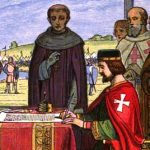 Animals
Animals  Animals
Animals  History
History 10 Most Influential Protests in Modern History
 Creepy
Creepy 10 More Representations of Death from Myth, Legend, and Folktale
 Technology
Technology 10 Scientific Breakthroughs of 2025 That’ll Change Everything
 Our World
Our World 10 Ways Icelandic Culture Makes Other Countries Look Boring
 Misconceptions
Misconceptions 10 Common Misconceptions About the Victorian Era
 Mysteries
Mysteries 10 Strange Unexplained Mysteries of 2025
 Miscellaneous
Miscellaneous 10 of History’s Most Bell-Ringing Finishing Moves
 History
History 10 Great Escapes That Ended Right Back in Captivity
 Weird Stuff
Weird Stuff 10 Fascinating Things You Might Not Know About Spiders
 Animals
Animals 10 Animals That Humiliated and Harmed Historical Leaders
 History
History 10 Most Influential Protests in Modern History
 Creepy
Creepy 10 More Representations of Death from Myth, Legend, and Folktale
Who's Behind Listverse?

Jamie Frater
Head Editor
Jamie founded Listverse due to an insatiable desire to share fascinating, obscure, and bizarre facts. He has been a guest speaker on numerous national radio and television stations and is a five time published author.
More About Us Technology
Technology 10 Scientific Breakthroughs of 2025 That’ll Change Everything
 Our World
Our World 10 Ways Icelandic Culture Makes Other Countries Look Boring
 Misconceptions
Misconceptions 10 Common Misconceptions About the Victorian Era
 Mysteries
Mysteries 10 Strange Unexplained Mysteries of 2025
 Miscellaneous
Miscellaneous 10 of History’s Most Bell-Ringing Finishing Moves
 History
History 10 Great Escapes That Ended Right Back in Captivity
 Weird Stuff
Weird Stuff 10 Fascinating Things You Might Not Know About Spiders
10 Times Trickery Won Battles
Ordinarily, battles and wars are won by long-term preparation, military concepts, methods and the weapons available to both sides. While the outcome of battles could be predictable due to the level of preparation of one party compared to the other, for instance, a country with a thousand military aircraft is expected to triumph easily if it picks a fight with one with a hundred and fifty aircraft.
While simple mathematics would usually prevail in this type of equation, trickery is a factor that can flip the equation in favor of a party nobody expected to win. This is usually sensational when it happens.
These are ten times trickery won battles:
Related: 10 Often Forgotten Battles That Helped Shape the Modern World
10 Hannibal’s Double Envelopment at the Battle of Cannae
The Battle of Cannae, fought in 216 BC during the Second Punic War, stands as a masterclass in battlefield deception. Despite facing overwhelming Roman numbers, Carthaginian general Hannibal Barca used cunning tactics and strategic manipulation to orchestrate one of the deadliest ambushes in military history.
After crossing the Alps with his army and war elephants, Hannibal won a series of victories, including at Trebia and Lake Trasimene. In response, Rome assembled a massive army—nearly 80,000 infantry and 6,000 cavalry—under the joint command of consuls Lucius Aemilius Paullus and Gaius Terentius Varro. Hannibal had about 40,000 infantry and 10,000 cavalry, significantly outnumbered.
But what he lacked in manpower, he made up for in planning. He deliberately chose the battlefield near Cannae, where flat terrain favored cavalry maneuvers and wind-blown dust from the sea would hinder Roman visibility. He also knew the Romans were impatient and eager to crush him in open battle.
Hannibal arranged his troops in a crescent formation, placing his weaker Spanish and Gallic infantry in the center, with his stronger African veterans positioned at angles on either flank. His cavalry was divided on both wings, with his brother Hasdrubal on the left and Hannibal coordinating the entire force.
As the battle began, the Roman army, under Varro’s command that day, drove forward in a dense column to smash through the Carthaginian center. The center gave ground and gradually fell back—seemingly on the verge of collapse. But it was all part of the plan. As the Roman legions surged into the center, the African infantry on either flank pivoted inward, forming a U-shaped pocket. At the same time, Hasdrubal’s cavalry routed the Roman horsemen and wheeled around to strike from the rear.
The result was a textbook double envelopment. The Romans were trapped on all sides—pinned front and back, flanked on both sides, and hemmed in with no room to maneuver. In the choking dust and chaos, Roman formations crumbled. The slaughter was immense. Of the 80,000 Romans who entered the battle, as many as 50,000 to 70,000 were killed in a single day. Only a few thousand escaped. Consul Paullus was killed; Varro fled with a small remnant. Carthaginian losses were minimal by comparison.
Hannibal’s victory at Cannae remains one of the greatest tactical feats in history. His use of deception, terrain, and enemy psychology turned inferior numbers into overwhelming triumph.[1]
9 The Feigned Retreat at the Battle of Hastings
The Battle of Hastings, fought on October 14, 1066, was a pivotal clash between the Norman forces led by William, Duke of Normandy, and the English army under King Harold Godwinson. One of the most decisive tactics that led to William’s victory was the feigned retreat, a deceptive maneuver that lured the English troops out of their strong defensive positions and ultimately broke their shield wall, sealing the fate of the English army.
At one point during the battle, a section of the Norman cavalry apparently broke ranks and began to flee downhill from the battlefield. The English, believing they had won or that the enemy was in full retreat, broke their disciplined formation and pursued them down the slope.
This was exactly what William had planned. The “retreat” was a ruse—a deliberate tactic designed to lure the English off the high ground and away from their defensible position. Once the English had pursued the fleeing Normans far enough, the Norman cavalry suddenly stopped, turned around, and counterattacked the now-exposed and disorganized English soldiers.
This sudden reversal caught the English off guard. The tightly knit shield wall was broken as soldiers became separated and vulnerable. The Norman cavalry and infantry then exploited the gaps to inflict heavy casualties and push the English lines back. This feigned retreat was reportedly repeated multiple times during the battle, each time drawing more English men into pursuit and gradually eroding the shield wall’s strength. Over time, the discipline and cohesion of the English forces crumbled, making them easier targets for the Normans.
In the end, William’s victory at Hastings led to the Norman conquest of England, transforming English culture, language, governance, and society.[2]
8 Japan Bluffed Their Way to Victory in the Battle of Singapore
The Battle of Singapore, fought from February 8 to 15, 1942, was one of the most stunning defeats in British military history. Despite being outnumbered and undersupplied, the Japanese used speed, deception, and bold tactics to capture what was considered an “impregnable fortress.” Central to their victory was a strategic bluff that convinced the British they faced a far larger force than they actually did.
British commanders, led by Lieutenant-General Arthur Percival, expected a naval attack on Singapore’s heavily fortified southern coast. However, the Japanese, under General Tomoyuki Yamashita, crossed from the north, through the Johor Strait, where defenses were weakest. Yamashita had roughly 30,000 to 35,000 troops, while the British, including Australian, Indian, and local units, numbered around 85,000. Knowing he lacked the manpower and supplies for a prolonged battle, Yamashita relied on bluff and psychological warfare.
He launched bold attacks with loud noise, rapid movements, and deception to give the impression of overwhelming strength. Japanese troops lit numerous campfires, spread out to seem more numerous, and frequently changed positions to simulate troop rotations.
In addition, the Japanese used false radio traffic and staged communications to suggest reinforcements were arriving. Yamashita sent an ultimatum demanding surrender. Percival, believing he was surrounded by a massive force and fearing civilian casualties, chose to surrender—unaware he was giving in to a much smaller force that was short on ammunition and supplies.[3]
7 Operation Fortitude
Operation Fortitude was a critical deception campaign conducted by the Allies during World War II to mislead the German military about the location and timing of the D-Day invasion. This operation played a vital role in ensuring the success of the Allied landings in Normandy on June 6, 1944.
Operation Fortitude was divided into two main parts: Fortitude North and Fortitude South. Fortitude North aimed to convince the Germans that the Allies would invade Norway, while Fortitude South was designed to make them believe the main invasion force would land at Pas de Calais, the narrowest point between Britain and France, rather than Normandy.
To execute this deception, the Allies used a combination of fake equipment, dummy landing craft, double agents, and misleading radio traffic. A key element of Fortitude South was the creation of a fictitious First U.S. Army Group (FUSAG), supposedly led by General George S. Patton, one of the most respected and feared Allied commanders. Inflatable tanks, fake camps, and fabricated orders created the illusion of a massive force preparing to strike at Calais. Double agents such as Juan Pujol García (codename “Garbo”) fed false intelligence to the Germans, reinforcing the narrative that the Calais region was the true target.
The Allies also staged dummy radio transmissions and leaked misleading plans to ensure the Germans remained convinced of this alternate scenario. As a result of Operation Fortitude, the Germans held back significant forces in the Pas de Calais region even after the Normandy landings began. Believing that the Normandy invasion was a diversion, German high command delayed sending reinforcements, expecting a second, larger attack at Calais.
This hesitation allowed the Allies to establish and expand their beachhead in Normandy with less resistance than they would have otherwise encountered.[4]
6 Double Bluff and Feint Retreat at the Battle of Cowpens
At the Battle of Cowpens on January 17, 1781, during the American Revolutionary War, General Daniel Morgan masterfully used tactics of double bluff and feigned retreat to lure the British into a devastating trap. Facing a professional force led by the aggressive British commander Lieutenant Colonel Banastre Tarleton, Morgan crafted a battlefield plan that exploited British overconfidence and used psychological warfare to turn the tide in favor of the Continental Army.
Morgan understood Tarleton’s impulsive nature and designed his defense to manipulate it. He positioned his troops in three successive lines: first, a skirmish line of sharpshooters, then a militia line with orders to fire two volleys before retreating, and finally, a solid line of Continental regulars hidden behind a slight rise.
This layered defense was key to the double bluff. The skirmishers fired and fell back, followed by the militia who also retreated after delivering their volleys. To the British, this appeared to be a full-scale retreat, reinforcing their belief that the Americans were breaking under pressure.
Tarleton, eager for a swift victory, ordered his men to charge, convinced that the American forces were collapsing. What the British didn’t realize was that this “retreat” was a calculated feint. As the British advanced in disorder, thinking the battle was nearly won, they rushed into the waiting third line of Continental troops. At that moment, Morgan’s regulars stood firm and opened fire at close range, inflicting heavy casualties. Simultaneously, the militia regrouped and returned to the fight, flanking the now-exposed British force.
This clever double bluff—appearing to flee, then striking when the enemy was disorganized—trapped the British in a deadly crossfire. Tarleton’s men were encircled, demoralized, and ultimately overwhelmed. The British suffered significant losses, with around 800 of their 1,100 troops killed, wounded, or captured. American casualties were minimal by comparison.
Morgan’s use of feigned retreat and deception at Cowpens was a textbook example of tactical ingenuity. It exploited enemy psychology, used terrain effectively, and demonstrated how a smaller, less experienced force could defeat a professional army. The victory boosted American morale and helped shift momentum in the Southern campaign, eventually contributing to the British surrender at Yorktown later that year.[5]
5 Napoleon Deliberately Created a Weak Point at the Battle of Austerlitz
Napoleon’s use of feint at Austerlitz began with the appearance of weakness. He deliberately weakened his right flank and withdrew some troops from the strategic Pratzen Heights in the center. By doing so, he lured the Allies into believing that his army was vulnerable and that a decisive attack on the French right would break his lines. The Allied commanders, especially the overconfident Russian General Kutuzov and Austrian General Prince Schwarzenberg, took the bait.
They planned a massive assault on the right, expecting to roll up Napoleon’s lines and force a French retreat. This apparent vulnerability was a calculated deception. In reality, Napoleon had hidden his strongest forces in reserve behind the center and flanks, especially under the command of Marshal Soult. As the Allies moved forward to attack the right, they left the Pratzen Heights relatively undefended, assuming the French had abandoned them.
This was the core of Napoleon’s feint—he created the illusion of a weak point to draw the enemy into a trap. As the Allied forces became overextended and disorganized in their attack, Napoleon launched his decisive counterstroke. He ordered Soult’s corps to surge up and seize the Pratzen Heights. This unexpected maneuver split the Allied army in two, placing the French in control of the battlefield’s dominant high ground.
From this position, Napoleon’s forces unleashed devastating attacks on the flanks of the now-fractured enemy lines. The result was a catastrophic defeat for the Allies. They suffered around 36,000 casualties, including killed, wounded, and captured, compared to France’s 9,000.
The success of the battle hinged on Napoleon’s feint: he manipulated enemy expectations, allowed them to commit to a flawed plan, and then counterattacked with precision.[6]
4 Battle of Gaugamela
At the Battle of Gaugamela in 331 BC, Alexander the Great achieved a stunning victory over the vastly larger Persian army of King Darius III through a combination of brilliant tactics, precise maneuvering, and deception. Alexander faced an enormous Persian army—possibly over 200,000 troops—while commanding about 47,000 men. Darius had chosen the flat plains of Gaugamela (modern-day Iraq) specifically to maximize the effect of his cavalry and war chariots.
Alexander knew he couldn’t win with force alone, so he used deception to break Persian coordination. One of Alexander’s key deceptive tactics was his oblique advance to the right. As the battle began, Alexander didn’t charge directly into the Persian center. Instead, he led his elite Companion cavalry and some infantry diagonally to the right, away from the center and toward the Persian left flank.
This movement appeared puzzling to the Persians. It looked like Alexander might be trying to retreat or outflank them. Fearing that his left would be bypassed, Darius ordered part of his cavalry to shadow Alexander’s movement and extend their line. This was exactly what Alexander wanted: the Persian line became stretched and thinner, creating a gap in their center—a vulnerable point between the infantry and the cavalry.
As soon as Alexander saw the gap open in the Persian center, he gave the signal. With perfect timing, he wheeled left and charged directly into the gap with his Companion cavalry and supporting infantry. This sudden pivot and assault shocked the Persians, driving toward Darius himself. Darius panicked and fled the field in his chariot, triggering a general rout of the Persian army.
[7]
3 Operation Mincemeat
Operation Mincemeat was a British intelligence operation during World War II that played a critical role in deceiving Nazi Germany and securing a successful Allied invasion of Southern Europe.
Executed in 1943, the plan was part of a broader effort to divert German forces away from Sicily, the actual target of the upcoming Allied invasion (Operation Husky), by convincing them that Greece and Sardinia were the real objectives.
At the heart of Operation Mincemeat was a corpse—a dead body carefully dressed up as “Major William Martin” of the Royal Marines. British intelligence planted false documents on the body, including a letter suggesting that the Allies planned to invade Greece and Sardinia.
The goal was to have the body wash up on the Spanish coast, where it would be discovered by local authorities and, eventually, passed on to German intelligence. Spain, though officially neutral, had elements within its government and military that were sympathetic to the Axis powers, making it an ideal place for such an operation.
The corpse was released from a British submarine near the Spanish coast in April 1943. As hoped, Spanish officials found the body and allowed German agents to examine the documents before returning them to the British—unaware that they had been tampered with.
The documents were deliberately misleading, crafted to appear confidential and authentic. They even included fake personal letters and receipts to enhance the illusion that “Major Martin” was a real officer.
German intelligence fell for the ruse. Hitler and the German High Command believed the misleading documents and began shifting troops and defenses toward Greece and the Balkans, weakening their hold on Sicily.
This deception created a crucial window of opportunity for the Allies. When the invasion of Sicily commenced on July 9, 1943, it faced far less resistance than expected. The success of the campaign helped the Allies establish a strong foothold in Southern Europe and eventually led to the fall of Mussolini’s regime in Italy.[8]
2 Hannibal Lures Romans into Ambush at the Battle of Lake Trasimene
The Battle of Lake Trasimene, fought in 217 BC during the Second Punic War, stands as one of the most brilliant examples of military deception in history. Hannibal, the Carthaginian general, used the terrain, weather, and the psychology of his Roman enemies to orchestrate a devastating ambush against the Roman consul Gaius Flaminius.
After crossing the Alps and winning earlier battles, Hannibal moved south into Italy. He lured the Romans into pursuing him by conducting a scorched-earth campaign, sparing only the lands of those allied with him.
This enraged Flaminius, who marched aggressively to confront Hannibal without proper reconnaissance or formation. Hannibal selected the northern shore of Lake Trasimene for his trap—a narrow, fog-covered path between the lake and hills, perfect for an ambush. He concealed his infantry and cavalry in the forested slopes surrounding the path.
Early in the morning, as a thick mist hung over the lake, Flaminius marched his army through the defile, unaware of what awaited. Once the Romans were fully within the trap, Hannibal signaled the attack. His troops descended from the hills, striking from the flanks and rear while blocking the path forward. The Romans, confined by terrain and shrouded in fog, couldn’t organize a defense or retreat effectively. The sudden and chaotic assault shattered their ranks.
The result was a catastrophic defeat for Rome: nearly 15,000 Roman soldiers were killed, and many others were captured. Flaminius himself died in the fighting. Using the environment, surprise, and Roman overconfidence, Hannibal’s deception led to a total tactical victory without a formal battle line.[9]
1 The English Tricked the French into Mud at the Battle of Agincourt
The Battle of Agincourt, fought on October 25, 1415, during the Hundred Years’ War, is often remembered for the English army’s stunning victory against a numerically superior French force. While terrain, weather, and English longbows played crucial roles, deception—both strategic and tactical—was also key to the English success.
King Henry V of England had marched his exhausted, disease-weakened army across northern France after the siege of Harfleur. The French believed they could easily crush him and blocked his path to Calais with a much larger force. Confident in their numbers and expecting a straightforward win, the French prepared for a conventional battle, focusing on honor and chivalric ideals rather than pragmatic strategy.
Henry, however, used deception to mask his army’s weaknesses. He deliberately underplayed the English position and intentions, encouraging the French to believe they would face a disorganized and demoralized foe. On the day of the battle, Henry arranged his troops cleverly in a narrow, muddy field flanked by woods—perfect for neutralizing the French numerical advantage. Henry also gave the false impression of passivity, waiting for the French to attack.
When they delayed, he seized the initiative, advancing his longbowmen to provoke a charge. The French knights, believing they could easily overwhelm the English, took the bait. But their heavily armored cavalry and infantry were funneled into a tight, muddy killing zone, where English archers rained arrows and disrupted their ranks. In the confusion, French forces trampled each other, and many were killed or captured.
Henry’s use of deception—misrepresenting his army’s condition, luring the French into poor tactical decisions, and choosing ground that played to his strengths—turned the odds in his favor. Agincourt became a legendary English triumph, with deception a vital element of the victory.[10]








